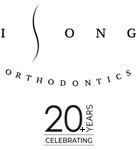Orthodontic Care Guide in Berkeley, CA
At I Song Orthodontics, we are proud to provide expert orthodontic care to patients of all ages. Whether you’re exploring Invisalign® or traditional braces, we’ll help you find the best solution for your smile and your lifestyle.
Oral Hygiene with Braces
Braces require a little extra attention when it comes to daily care. The wires and brackets can trap food and plaque, increasing your risk of cavities and gum issues. Here’s how to keep your teeth healthy during treatment:
Braces require a little extra attention when it comes to daily care. The wires and brackets can trap food and plaque, increasing your risk of cavities and gum issues.
Here’s how to keep your teeth healthy during treatment:
Brushing
- Use a soft-bristled toothbrush and small, circular motions to clean around brackets and along the gumline.
- Brush at a 45-degree angle to reach under the wires and clean every tooth surface.
Flossing
- Flossing is crucial while wearing braces, even though it takes more effort.
- Use floss threaders or orthodontic flossers to make the process easier.
- Think of it this way: clean braces = clean teeth!
What Foods to Avoid with Braces
Braces may be strong, but they’re not indestructible. Certain foods can damage your brackets or wire and slow your progress.
Sticky & Sugary Foods (they cling to brackets and increase decay risk):
✔ Gum (sugar-free or regular)
✔ Caramels, taffy, toffee
✔ Licorice, Starburst, Skittles
✔ Carbonated drinks and soda
Hard Foods (they can break or bend appliances):
✔ Ice
✔ Nuts
✔ Hard taco shells, crusty bread, chips
✔ Hard candies like lollipops, Jolly Ranchers, Lifesavers
✔ Whole apples, raw carrots, and corn on the cob should be cut into small pieces if eaten
Orthodontic Tips & Tricks:
✔ Avoid biting into fruits with pits (like peaches).
✔ Avoid biting and pulling foods (this puts stress on the brace)
✔ Cut the meat off the bone.
✔ Don’t chew on non-food items like pens or fingernails.
Safe & Braces-Friendly Foods
Don’t worry, there are still plenty of tasty, safe options!
Soft Proteins & Grains:
✔ Meatloaf, pulled meats, turkey burgers
✔ Tofu, quinoa, pasta, brown rice
Dairy & Eggs:
✔ Yogurt, cottage cheese, egg salad, scrambled eggs
Fruits & Veggies (soft or cooked):
✔ Applesauce, bananas, cooked vegetables
✔ Smoothies, mashed potatoes, shredded carrots
Other Great Options:
✔ Hummus, baba ghanoush, soup, curry
✔ Sushi (without crunchy fillings), soft breads, oatmeal
Caring for Your Palatal Expander (RPE)
A Rapid Palatal Expander (RPE) widens the upper jaw to correct bite issues and create space. It’s most effective in younger patients whose jaws are still developing.
Here’s what you might experience:
- Mild discomfort or pressure (especially 48–72 hours after placement)
- Temporary speech changes and swallowing difficulty
- A gap between front teeth (totally normal—it means it’s working!)
Using the RPE Key:
- Insert the key into the 12 o’clock position (pointing toward the nose).
- Turn it gently and steadily as directed:
- Patients: Turn counterclockwise using the target-marked handle.
- Parents/Caregivers: Turn clockwise.
- Follow your turning schedule exactly as instructed.
- Avoid chewing gum, hard candy, or ice, and don’t poke at the expander with your tongue or fingers.
Invisalign Care & Instruction
At I Song Orthodontics, we’re committed to helping you achieve a healthy, confident smile with Invisalign®. To get the best results, proper care and wear are essential. On this page, you’ll find everything you need to know about caring for your aligners, cleaning tips, wear schedules, and what to expect throughout your treatment. Whether you’re just starting or need a quick refresher, our Invisalign® care guide ensures your treatment stays on track, comfortably and effectively.
Invisalign® aligners are nearly invisible and removable, making them a convenient choice for teens and adults alike. However, to maintain your progress, it’s important to wear them for the recommended 20–22 hours per day, clean them properly, and handle them with care. Our team is always here to support you throughout your journey, just a call or message away if questions come up.
Frequently Asked Questions (FAQ)
Q: How long should I wear my Invisalign® aligners each day?
A: For optimal results, wear your aligners 20–22 hours a day. Only remove them to eat, drink (except water), and brush/floss.
Q: How do I clean my aligners?
A: Rinse them with lukewarm water and brush gently with a soft toothbrush. Avoid using toothpaste, as it can scratch the plastic. Invisalign® cleaning crystals or a clear retainer cleaner are also great options.
Q: Can I eat or drink with my aligners in?
A: You should remove your aligners when eating or drinking anything other than water to avoid staining or damaging them.
Q: What should I do if I lose or break an aligner?
A: Contact I Song Orthodontics right away. We’ll advise whether to move to your next aligner or order a replacement.
Q: Is it normal to feel discomfort when switching aligners?
A: Mild discomfort or pressure is normal when starting a new set. It usually subsides within a day or two and is a sign that the aligners are working.
Have a Problem? Call Us!
If you notice a loose bracket, broken wire, or anything unusual, call our office at (510) 528-2220 so we can get you in for a repair. Don’t forget to visit our Facebook!
